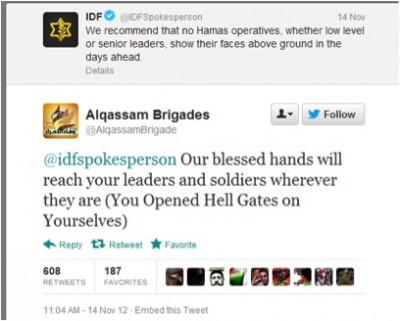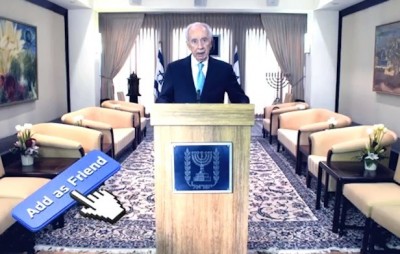The (music) video is truly bizarre; I couldn’t believe it was an official state-sponsored production and not the work of a media savvy amateur prankster. Sure, we’ve all seen Barack Obama chime in on the “Call Me Maybe” mayhem, but that was an amateur remix. Imagine if the office of the White House had actually put something like that out.
The Peres video features an official looking President Peres scrolling through his Facebook page on an iPad, embracing world leaders like Hilary Clinton and watching a robot dance. The whole song consists of about two phrases, repeated over and over and over again. Simply put, it’s tacky. And has been stuck in my head for two days.
One must wonder if this video is a genuine attempt to spread the message that Israel wants peace.
While it undoubtedly makes a mockery of public relations efforts, it also raises really interesting questions about the evolution of international diplomacy, national branding, and communication in the modern era.
For instance, who is this video’s intended audience? And what does the repetition of a cliché’d synthesized appeal for peace actually communicate?
The video also serves as a really interesting commentary on the increasing role of technology in international relations and state affairs. In that vein, more recently some crazy things have been happening on the Twitterverse (the Twitter-Universe, for those of you trapped in 2008).
For perhaps the first time in history, a military operation was declared via Twitter when the handle @IDFSpokesperson tweeted on Wednesday night: “We recommend that no Hamas operatives, whether low level or senior leaders, show their faces above ground in the days ahead.” And thus, in 140 characters or less, the IDF initiated Operation Pillar of Defense (which, in case you missed it, is in fact ‘trending’).
Though this may be considered old news in the ever-changing social media world, I think it is worthy of a thoughtful pause. Consider what it means to have a war announced through Twitter.

That the IDF would tweet a military charge is intriguing. More astounding were the responses. The handle @AlquassamBrigade, which purports to represent the official Al Qassam Brigades in Palestine, tweeted back: “@idfspokesperson Our blessed hands will reach your leaders and soldiers wherever they are (You Opened Hell Gates on Yourselves).”
In the same 24 hour period, it should be noted, the IDF uploaded a video to YouTube of its targeted assassination of Ahmed Al-Jabari the Hamas militant mastermind.
Promises of takedown aren’t anything new for Twitter (the latest Nicki Minaj and Mariah Carey disputes promise a hot and heavy interchange). In fact, celebrity antagonism is what makes Twitter so juicy. But what happens when real wars, where people are killed and maimed, are represented through verbal sparring on the interwebs? That the IDF and Al Quassam brigade are now engaging in micro-blogging warfare makes me rethink the material import of Facebook, Twitter, and the entire internet industry. It also makes me re-think what it means to have a conflict in the 21st century.
It’s also fascinating that all of this is taking place one week after we’ve seen the first President-elect declaration of victory to take place via Twitter. President Obama’s tweet of him hugging his wife with the caption “Four more years” has since become the most retweeted item on the site.
It’s almost as if the world of international politics is playing a joke on the Internet. Or on each other. Or on us. One thing’s for sure: it’ll be a while until we figure out the ethics of this new age of cyber communication, diplomacy, and warfare. Until then, I like many, will be sitting here #confused.
![shimonperesfriend1_616 Shimon Peres raps for peace [CC: webpronews.com]](https://newvoices.org/wp-content/uploads/2012/11/shimonperesfriend1_616.jpeg)

